Fifty years ago, a top-flight Hollywood team of animation and music talents brought Yogi Bear and friends to the big screen and to a soundtrack album.

HEY THERE, IT’S YOGI BEAR!
Original Soundtrack Recording
Colpix Records CP-472 (Mono) SCP-472 (Stereo) (12” 33 1/3 RPM LP / 1964)
Album Producer/Editor: Jack Lewis. Running Time: 28 minutes.
Performers: Bill Lee (Yogi Bear); Ernest Newton (Boo-Boo Bear); Jackie Ward (Cindy Bear); “Jonah and the Wailers”.
Songs: “Hey There, It’s Yogi Bear (Main Title)” by David Gates; “Like I Like You,” “St. Louie,” “Ash Can Parade,” “Ven-E, Ven-O, Ven-A,” “Whistle Your Way Back Home” by Ray Gilbert and Doug Goodwin.
Instrumentals: “Yogi’s Nap,” Yogi Bear March,” Yogi’s Merry Movements,” High Wire Cindy,” “Back to the Circus” by Marty Paich; “Like I Like You” (two instrumentals), “Whistle Your Way Back Home (Finale)” by Ray Gilbert and Doug Goodwin; “Hey There, It’s Yogi Bear (Finale)” by Doug Goodwin.
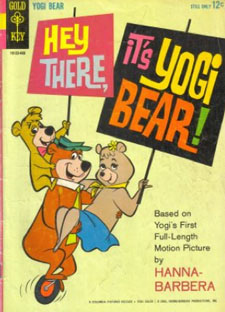 Hanna and Barbera enjoyed such success and growth by 1963, they were confident their characters and studio had the potential for expansion from TV into theatrical features, as well as other forms of entertainment. Some diverse avenues did see success, like the characters’ presence in the King’s Island and King’s Dominion theme parks, but their ventures into features didn’t really catch fire (1973’s Charlotte’s Web really became a fixture to its many fans through TV and home video).
Hanna and Barbera enjoyed such success and growth by 1963, they were confident their characters and studio had the potential for expansion from TV into theatrical features, as well as other forms of entertainment. Some diverse avenues did see success, like the characters’ presence in the King’s Island and King’s Dominion theme parks, but their ventures into features didn’t really catch fire (1973’s Charlotte’s Web really became a fixture to its many fans through TV and home video).
Hey There, It’s Yogi Bear (released in 1964) benefitted greatly from the infusion of talent from various studios after the short cartoon business all but dried up and Disney met with disappointing box office on 1959’s Sleeping Beauty. Among them were Willie Ito, Jerry Eisenberg, Iwao Takamoto, Charles Nichols, Dan Gordon, Dick Bickenbach, Ron Dias, Harry Holt, George Kreisl, Grant Simmons, Ed Aardal, Dick Kelsey and an uncredited Friz Freleng. This feature gave them a chance to offer what TV budgets wouldn’t allow: a lush look and fluid movement not seen in Hanna-Barbera animation with the exception of some commercials (when the sponsor was footing the bill).
Songwriter Ray Gilbert had also scored big for Disney in the 1940’s, when “Zip-A-Dee-Doo-Dah” (co-written with Allie Wrubel) won an Academy Award. Gilbert’s other song credits include “Blue Bayou,” “Cuanto La Gusta,” and two other important Disney tunes, “You Belong to My Heart (Solamente Una Vez)” from The Three Caballeros and “Merrily on Our Way” from Mr. Toad.
And yes, the composer/lyricist of the Hey There, It’s Yogi Bear title song is the same David Gates who later found fame with the pop group Bread (“Baby I’m-A Want You,” “Make It With You.”) In the early ‘60s Gates was an upcoming songwriter/producer/studio musician in Los Angeles, much as Danny Hutton was when he recorded several tunes for the Hanna-Barbera Records label before reaching fame with Three Dog Night.
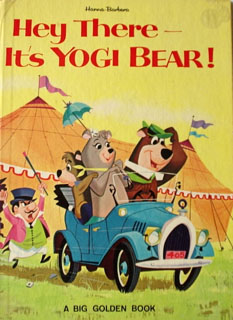 If it had existed in an earlier decade, Hey There, It’s Yogi Bear — and its score — might have had a bigger impact on filmgoers. The ‘60s saw dizzying changes in the entertainment world. Disney enjoyed big returns with 101 Dalmatians, Mary Poppins and The Jungle Book, but high-level animation was getting too costly. In a way, Hanna-Barbera was competing with itself, not only by doing a movie with characters people could see on TV for free, but with more cartoon series getting on the air (and more competition) every year.
If it had existed in an earlier decade, Hey There, It’s Yogi Bear — and its score — might have had a bigger impact on filmgoers. The ‘60s saw dizzying changes in the entertainment world. Disney enjoyed big returns with 101 Dalmatians, Mary Poppins and The Jungle Book, but high-level animation was getting too costly. In a way, Hanna-Barbera was competing with itself, not only by doing a movie with characters people could see on TV for free, but with more cartoon series getting on the air (and more competition) every year.
It was regular Hollywood practice for skilled studio singers, or “ghost singers,” to sing off-screen for actors without formal training. Off-screen singing was a bit of a tradition in Hollywood, to the point that it was standard procedure. Trained, proven singers could sight-read sheet music in seconds and lay down vocal tracks in perfect pitch, saving time and money. Ghost singers were usually kept secret until Marni Nixon, who had been threatened with expulsion from the industry if she revealed her craft, became well known after The King & I star Deborah Kerr was magnanimous enough to insist Nixon get proper recognition.
In the case of Hey There, It’s Yogi Bear, it might make sense for Jackie Ward (who also sang with The Partridge Family studio group) to sing for Julie Bennett as Cindy, since “Like I Like You” is essentially a singer’s song. But Yogi and Boo-Boo’s singing voices are so much like their speaking ones; it might have made more sense to bring in Daws Butler and Don Messick. It should be noted that Yogi was dubbed by the best in the business, not just James Darren but Bill Lee, the male Marni Nixon who sang for movie leads such as John Kerr in South Pacific, Tom Drake in Words and Music and most famously, Christopher Plummer in The Sound of Music.
It might have been nice if Colpix used snippets of dialogue to open the songs, so we got to hear a little of Yogi, Boo-Boo and Cindy. Lots of soundtrack albums have such clips and this LP sounds as if it had a better-than-the-average budget, so additional funds could have included Butler, Messick and Bennett.
The soundtrack album itself is fine listening, but nevertheless leaves one wanting more both musically and technically. Surely there were other sections of Marty Paich’s score that could have replaced one of the two tracks of a similar, repetitive circus theme. There was a nice melody under one of Yogi and Cindy’s early scenes that was heard on Kellogg’s mail order story record, but it isn’t included on this album.
More bizarre is the odd use of stereo on side one. Stereo was still a novelty in 1964, so it’s understandable that the chorus is shoved to the left channel on the title song to accentuate the separation between home stereo speakers. But there is no conceivable reason that the first instrumental of “Like I Like You” goes from mono to stereo for no discernable reason. Even more jarring is how most of “St. Louie”—which many feel is the breakout song (are the vocalists The Mills Brothers under a pseudonym?)—is presented in one-channel mono until the very last line of the song. Was producer/editor Jack Lewis distracted, bored, indifferent or inexplicably experimental during the session? Though the full stereo tracks without anomalies sound terrific, the mono album offers consistency.
GIVE A LITTLE LISTEN
“Hey There, It’s Yogi Bear Title Song” & “Whistle Your Way Back Home”
This is a montage of the film’s main title song, “Whistle Your Way Back Home” (which was the original title of the feature) and the finale, combining both. The slick, expansive arrangements of songs in both this film, H-B’s Alice in Wonderland and The Man Called Flintstone are the work of Marty Paich, who arranged for music’s biggest stars, including Frank Sinatra, Barbra Streisand, Sarah Vaughn, Linda Ronstadt and Sammy Davis, Jr.
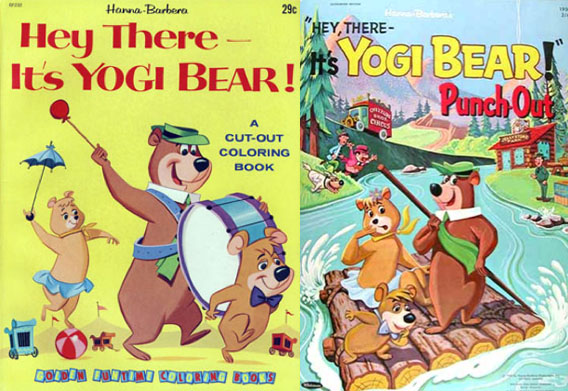
Two of Western Publishing’s activity book tie-ins.
HEY THERE, IT’S YOGI BEAR!
Radio Spot Announcements
Columbia Pictures Promotional Record SP-2341 (Mono) (10” 33 1/3 RPM LP / 1964)
Note that the announcer refers to the “St. Louie” bears as “The BEARtles.” Must have been a quick way to hook onto the burgeoning popularity of the fab four in ’64.
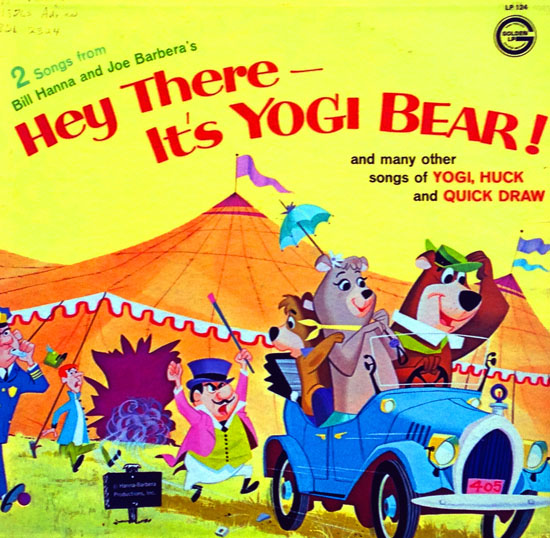
Two Songs from Bill Hanna and Joe Barbera’s
HEY THERE, IT’S YOGI BEAR
And Many Other Songs of Yogi, Huck and Quick Draw
Golden Records (Mono) LP-124 (12” 33 1/3 RPM LP / 1964)
Executive Producer: Arthur Shimkin. Musical Direction: Jim Timmens. Running Time: 34 minutes.
Performers: The Golden Singers, Frank Milano (Yogi, Boo-Boo, Ranger Smith, Huckleberry Hound, Quick Draw McGraw, Snuffles, Hokey Wolf, Ding-A-Ling, Snagglepuss, Loopy DeLoop, Major Minor, Kid Who Sounds Like Burr Tillstrom’s Kukla); Cecil Roy (Cindy Bear).
Yogi Bear Movie Songs: “Hey There, it’s Yogi Bear” by David Gates; “Ash Can Parade” by Ray Gilbert and Doug Goodwin.
Other Songs: “Yogi Bear Theme” by Bill Hanna, Joe Barbera and Hoyt Curtin; “Before Yogi,” “Yogi Bear Presents Cindy Bear (Howdy Y’all),” “Yogi Bear: Casanova of the Cave Set,” “Cindy Bear: Casanova of the Cave Set,” “Yogi, Huck and Quick Draw: Safety Song,” “Quick Draw’s A-Comin’,” “Quick Draw Presents Snuffles,” “Hokey Wolf and Ding-A-Ling,” “Snagglepuss March,” “Major Minor,” “Loopy DeLoop Meets Little Red Riding Hood (Parody of ‘Bicycle Built for Two’),” by Paul Parnes.
Only two songs from the Hanna-Barbera feature appear on this album, with a hefty helping of previously released songs based on the characters. None of the early Gil Mack performances (with Jimmy Carroll and Mitch Miller directing) are present. Everything is from the ‘60s Golden era of mellow Jim Timmens arrangements, except for the two new songs, which ironically sound a little like the Carroll/Miller style.
 Once again, low budgets and a softer market makes for sparse production quality and the infamous work of, as I used to say as a kid, “not the real voices.” Frank Milano was a busy voice actor in those days, mostly in radio and TV commercials. He also made some vocal appearances on Total Television cartoons—and recorded a number of Golden Records, most notably The Poky Little Puppy read-along. Cecil Roy’s radio career was very distinguished, playing children many times—and in a decidedly non-Cindy twist, played a giant spider in an episode of the radio horror show Quiet Please called “The Thing On the Fourable Board” starring Vincent Price. She was best known for being the voice of Little Lulu in the Famous Studios cartoons of the 1940s.
Once again, low budgets and a softer market makes for sparse production quality and the infamous work of, as I used to say as a kid, “not the real voices.” Frank Milano was a busy voice actor in those days, mostly in radio and TV commercials. He also made some vocal appearances on Total Television cartoons—and recorded a number of Golden Records, most notably The Poky Little Puppy read-along. Cecil Roy’s radio career was very distinguished, playing children many times—and in a decidedly non-Cindy twist, played a giant spider in an episode of the radio horror show Quiet Please called “The Thing On the Fourable Board” starring Vincent Price. She was best known for being the voice of Little Lulu in the Famous Studios cartoons of the 1940s.
With all due respect to Milano, who does his best, he isn’t Daws Butler. While he can voice Yogi better than I can (almost everyone can go “Hey-hey-hey-HEY!”), the voice is just an element of what Butler did with his vocal performance, especially in the feature film, requiring Yogi to have a greater range of emotions than the TV cartoons usually did.
GIVE A LITTLE LISTEN
“Ash Can Parade”
This song probably enjoyed the most exposure outside of the feature, appearing on this Golden Record and also on the Kapp album, Marching Along Together with the Do-Re-Mi Children’s Chorus. All the Gilbert/Goodwin songs must have been created in part for wider appeal, performance and cover versions in hopes that they might achieve some of the “standard” status of Disney and other movie and show songs.


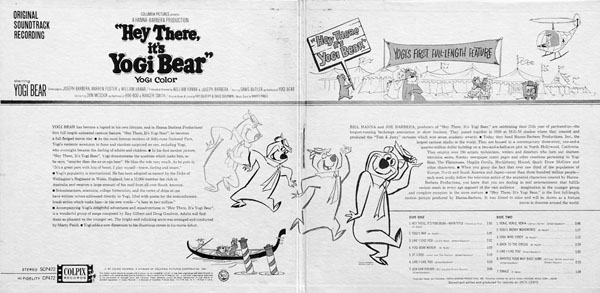
 GREG EHRBAR is a freelance writer/producer for television, advertising, books, theme parks and stage. Greg has worked on content for such studios as Disney, Warner and Universal, with some of Hollywood’s biggest stars. His numerous books include Mouse Tracks: The Story of Walt Disney Records (with Tim Hollis). Visit
GREG EHRBAR is a freelance writer/producer for television, advertising, books, theme parks and stage. Greg has worked on content for such studios as Disney, Warner and Universal, with some of Hollywood’s biggest stars. His numerous books include Mouse Tracks: The Story of Walt Disney Records (with Tim Hollis). Visit 






















































Greg:
The selections from the soundtrack sounded really good (I”m partial to the instrumental tracks myself)but but Daws,Don and Julie should have been allowed to excersise their singing chops.That would have made the album that much more enjoyable!And those radio spots were good,but really…the BEARtles?Wonder if Joe Barbera was the one who threw in that suggestion?” “The Beatles are hot ! Why not …?
Saw this and the Flintstone movie in the theater as a manly little fellow.
Two things:
— How did a gag of Yogi hiding in a small refrigerator survive safety-minded clippers?
— Is this the first appearance of the snickering dog who evolved into Precious Pup and later Muttley?
From most accounts, “Mugger” is the first Don Messick snickering dog (right, Don Yowp?).
Restrictions about such things as the refrigerator gag were not as strict in movies as on TV, and there were fewer groups and individuals presiding over such things in those days, so it was probably overlooked as being questionable. And syndicated TV was less restricted than network TV, even in the ’90s.
Actually,there was a snickering dog character who had appeared in several early Huckleberry Hound cartoons.
The snickering dog actually goes all the way back to Tex Avery’s 1948 effort,. “Bad Luck Blackie”. As noted, Hanna-Barbera borrowed the idea for several supporting characters prior to this, and of course would keep using the bit before finally finding a hit character with Mutley four years after Yogi’s movie.
1963? There was talk in the trade papers in 1960–before Yogi even had his own show–of putting him in a feature film. Clearly he’d eclipsed Huck as the top star of their TV shorts.
DB, the snickering dog idea goes back to the Huckleberry Hound show. Read here
Yowp & Bill,
I thought maybe there was such a dog on Huck’s show. Thanks for the info!
Surprised by the length of the history and thoroughly impressed by the scholarship.
How long do you think somebody would last, using that laugh as a ringtone?
This is a great soundtrack!
It’s clear that Hanna and Barbera were going for a more sophisticated audience with this endeavor. The lyrics to “Like I Like You” and “Ven-E, Ven-O, Ven-A” are very adult, and comparable to many of the musical numbers that were in vogue in other musicals of the time. Yet there is plenty of “screen business” going on during the songs to keep kids from getting bored–as when the Venice fantasy scene focuses on Boo Boo’s antics as gondolier while Yogi is singing to Cindy.
Also noteworthy are the design changes that were made to Cindy Bear and Ranger Smith for this film. Heretofore, Cindy had been in her “blue period” when she was literally drawn as a blue bear, a bit heavier set, always wearing a hat that sort of resembled an upside-down pic-a-nic basket. For the film, the artists slimmed her down and made her a brown bear, took away the hat and gave her a more appealing scarf instead. However, it’s fortunate that a new voice was not considered necessary, as Julie Bennett had been doing a fine voice job with Cindy from the beginning, and both Cindy and Julie get a chance to shine in this storyline. I agree that Miss Bennett probably could have done her own singing, especially as “I Like You Like Me” while catchy, is not too vocally demanding. Also Ranger Smith was likewise slimmed down and given a more appealing appearance. Interesting to note that in all of the Yogi Bear projects that followed, the design of Ranger Smith (except for his hair being blond in the “Yogi’s Gang” series) and Cindy Bear were kept consistent with their “Hey There” makeovers.
It would be interesting to get a little more info on the “mail order story record”. The only version I have heard is full of annoying skips, but it’s still a pretty satisfying complement to the soundtrack album. It’s a shame that Daws Butler’s voice is not heard once on the album–his Yogi voice was unfortunately underused when it came to the records. Other artists did their best to imitate the Yogi voice, and are to be commended for their efforts (Allan Melvin came closest in my estimation) but nobody could beat Daws for the true voice of the “smarter than the average bear.”
Nice thoughts as usual, Frederick. I always found “blue Cindy” be kind of odd-looking. I seem to remember on Stu’s Show someone mentioning that The Man Called Flintstone set the next standard for future “looks” of the characters and Bedrock.
Nice thoughts as usual, Frederick. I always found “blue Cindy” be kind of odd-looking. I seem to remember on Stu’s Show someone mentioning that The Man Called Flintstone set the next standard for future “looks” of the characters and Bedrock.
It sorta did too with the way Barney now has those blackened eyes instead of ovals, though Wilma’s pink gown didn’t last too long I noticed (at least i noticed it popping up a few times such as in one of the earlier Pebbles commercials).
In the case of Cindy and Ranger Smith, their appearance in the movie pretty much cemented that design they would be seen as since, give how many spin-offs or merchandised artwork I had seen of them in my lifetime.
Anyone know why the main title credits with the theme song are excised for TV airings? The Man Called Flintstone is always left intact.
Don’t know why, but it’s a shame. I love the titles for this and the Flintstones feature (ever notice how the Man Called Flintstone titles slightly resemble the Abbott and Costello titles? I miss Wllma holding the Columbia torch that was excised from the DVD, likely for legal reasons. I think the VHS has it, though.
The VHS version of Man Called Flintstone has the Columbia logo featuring Wilma. If one owns a DVD recorder, it is possible to have a DVD copy with the original logo. Never cared much for the substitution that was done on several video versions as well as the “official” DVD release to cover up those few seconds. I don’t see that it would have done any harm to keep the original credits sequence intact, esp. as it sets the tone for the whole movie. First time I saw the movie I laughed out loud at the Columbia opening.
But back to “Hey, There”–those credits have never been shown intact on any version of the movie that I own. Anything noteworthy in the Columbia logo for the Yogi film?
The VHS version of Man Called Flintstone has the Columbia logo featuring Wilma. If one owns a DVD recorder, it is possible to have a DVD copy with the original logo. Never cared much for the substitution that was done on several video versions as well as the “official” DVD release to cover up those few seconds.
It was pretty crappy to say the least, I probably would’ve simply used another logo to pad over that part if I had to (the current owners of the film basically or whatever they want to brand it to).
I don’t see that it would have done any harm to keep the original credits sequence intact, esp. as it sets the tone for the whole movie. First time I saw the movie I laughed out loud at the Columbia opening.
It was a crying shame to see it gone.
But back to “Hey, There”–those credits have never been shown intact on any version of the movie that I own. Anything noteworthy in the Columbia logo for the Yogi film?
When “Hey There It’s Yogi Bear” aired on Cartoon Network back in the 90’s, they somehow got a version that opens with a Turner Pictures logo at the start, then the main film starts with the shot of the park waking up from winter as the credits were superimposed over the footage. It was kind of an odd decision to simply ditch the title song entirely there and I wonder why they did it at all. Wish I can find that to show an example, but here’s a trailer from whatever reissue that was…
https://www.youtube.com/watch?v=nPHElcXVgA8
In 1986 the film saw a theatrical re-release from Clubhouse Pictures, a subsidiary of Atlantic Entertainment Group. Their handling of the opening to the film had their logo come first with the first section of the music as heard on the LP coming in before it cuts to the 80’s “Hanna-Barbera Presents” logo and then the regular titles begin. This version was released on VHS from Paramount Home Video as well (imagine a H-B property on another studio label, the movie even saw airings on The Disney Channel during that time). I suppose that was an easier way to cover over the Columbia logo that had been there before, and really they could had done something like that for the DVD release we have now but instead that first few seconds of the music is cut off completely. Wouldn’t it had killed WB to simply stick in their logo to pad it out?
The QUIET PLEASE episode “The Thing on the Fourble Board” is one of the creepier items 1940s radio horror ever produced. Vincent Price isn’t in it, though. Ernest Chappell stars. I like the billing Roy, as the creature, is given at the end of the show: ” . . . and Cecil Roy was . . . (chuckles) also a member of the cast.”
That’s right! Good catch, Jon. I was confusing the two sides of the Radiola record that had both the Price and Roy shows.
I know that back when HEY THERE, IT’S YOGI BEAR was released theatrically, movie studios didn’t generally release financial information on their films or their box-office performance. Is there any indication at all, though, of how YOGI (and H-B feature follow-up A MAN CALLED FLINTSTONE) actually did theatrically? It’s probably safe to say they weren’t the hits H-B and Columbia were hoping for, but there’s a big difference between a disappointing performance at the box-office and just being out-and-out duds.
“A Man Called Flintstone” did poor enough business at the box office to cause Joe Barbera to say in 1977 that he would never again make a feature starring characters that the public could see for free on TV. He held to that sentiment until H-B made their “Jetsons” feature, which didn’t set the box office on fire, either.
I loved this movie beyond measure when it came out. I sat through it three times the day it opened, giving my mother conniptions, since she had no idea where I was.
Yeah, I loved this movie as a kid, and was very excited when it came out. I recall sending away for the Kellogg’s record, which I played quite a bit, in those days before home video. I believe I also had one of the coloring books based on the movie, but I can’t really remember which one. My memory is a little sketchy on that…
I had the Kellogg’s premium record when I was a kid. Saw a copy last year in a second-hand store and almost bought it until I noticed it was cracked. (If I recall correctly, it was a 7″ 33 1/3 disc, similar to the “Compact 33/Little LP” records made for juke boxes. Noticed the ads mentioning “Yogi Color;” Columbia’s ad department in the 60’s seemed to have a fetish for jokey names for the color process in their movies, “Camelot Color,” “Prehistoric Color,” etc; all of them were actually Eastman Color by Pathe’.
The record is pretty easy to find on eBay, sometimes even with the outside mailer.
HA! That was pretty standard….Eastmancolor in PARTICULAR from low budget studios went by these odd “ad hoc” names….some 1970s cartoons had “In Kandy Kane Kiddie Kolor” credit [I kid, uh, you not…the 1973 reissue of 1970’s “Santa and the Three Bears”, discussed by Greg E.earlier, was an example, so were several of the 1960s Japanese cartoons translated to English, like “Treasure Island” and “The Adventures of Huck Fin” or something like that”].
A couple times free downloads of the Hey There soundtrack were offered by blogs (one was Children’s Records and More I think). Somewhere I saw a site related to Doug Goodwin’s music and it had extra verses of “St Louie” that weren’t in the movie and not on the album. Marty Paich’s son David was very involved in music including rock band Toto.
It’s kinda fun to notice those little things you don’t think about when it comes to people and their connections.
Bob Nelson, I would love to find the the website of Doug Goodwin’s music with extra verses of “St Louis.” Now, 2020, I’m hustling to find any information on who “Jonah and the Wailers” were. They’re credited with performing “St. Louis” and I can’t find a single thing pointing me in the right direction.
I kind of wish that someone that has the Colpix Records CP-472/SCP-472 – Hey There It’s Yogi Bear (Soundtrack) (1964) Vinyl LP could eventually record it to their computer as either 320 bitrate MP3 files or lossless FLAC files in its entirety but separate each song track & instrumental score track as separate mp3 files meaning 14 separate MP3s per track on the original 14 song & score Vinyl LP and upload them to archive.org in a zip file or rar file and if possible could remaster the tracks to remove any pops, hisses, clicks, crackles, & noises that are not part of the songs or score as if they were released on a digital CD rerelease
Colpix Records CP-472/SCP-472 – Hey There It’s Yogi Bear (Soundtrack) (1964) Vinyl LP
Track List
01. Hey There, It’s Yogi Bear – Main Title (01:50) Chorus and orchestra by D. Gates
02. Yogi’s Nap (01:25) By Marty Paich
03. Like I Like You (02:32) Jackie Ward by Ray Gilbert and Doug Goodwin
04. Yogi Bear March (01:03) By Marty Paich
05. St. Louie (02:15) Jonah and The Wallers by Gilbert and Goodwin
06. Like I Like You (01:53) By Gilbert and Goodwin
07. Ash Can Parade (03:00) Bill Lee and Ernest Newton by Gilbert and Goodwin
08. Ven-e, Ven-o, Ven-a (02:48) James Darren by Gilbert and Goodwin
09. Yogi’s Merry Movements (01:17) By Marty Paich
10. High Wire Cindy (01:15) By Marty Paich
11. Back to the Circus (02:29) By Marty Paich
12. Like I Like You (01:20) By Gilbert and Goodwin
13. Whistle Your Way Back Home (02:15) Bill Lee, Jackie Ward, and Ernest Newton by Gilbert and Goodwin
14. Finale (01:28) By D. Gates